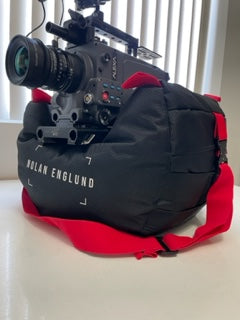
Lights, Camera, ACTION! How Hollywood Can Save the Planet (One Sustainable Take at a Time)
Hollywood, the land of glitz, glamour, and… gargantuan carbon footprints? The film industry, with its sprawling sets, energy-guzzling equipment, and globe-trotting productions, might conjure up an image far from eco-friendly.
But the tide is turning, and a green revolution is sweeping through filmmaking. Let's explore why sustainability is the future of cinema, and how it affects cinematographers and their crew.

The push for sustainable practices is gaining traction across the industry, driven by environmental concerns, shifting audience expectations, and even economic benefits.
Let's dive into this, shall we?
Europe is Leading the Charge
While Hollywood is often associated with excess, there's a growing movement toward sustainable practices across the globe, particularly in regions with stricter environmental regulations like the EU.
Productions often use renewable energy sources, embrace waste-reducing efforts, and minimize travel-related impact. They also choose local suppliers to minimize carbon footprint.
Ok you big bad Rat, Hollywood is toxic, and European green laws are good. But what exactly does this mean? How does this translate to the film set? What is actually the movie industry doing to pollute the world? Well, I'm glad you asked.
First, Those plastic bottles pile up! I mean it's one thing to buy a few plastic water bottles for you and your friend, but a big budget film can have over 100 crew members, that's like 100 bottles a day, for a year, that's around 24 000 plastic bottles. (if they don't work on the weekend and only drink 1 bottle a day).

And no matter how many big companies like to tell you, not all plastic can be recycled.
Oh, and if we include the amount of paper plates and forks catering uses as well into this plastic waste, and the list only just started.
Over Reliance on diesel generators is a serious polluter.
I mean, have you seen the size of those things? They need to be towed by an ever bigger truck, a whole crew to make sure it does not blow up, and then two more smaller generators on the side for good measure.

The Michael Bay problem
We all love a good explosion, and who does not love practical effects over the “good for nothing” CGI?
But there is a darker side to this.
Elaborate sets, and props that take weeks or even months to build, all blown up for a single shot. Where does all that debris go?
It might go to the museum or a lucky fan, or re-used in another movie, like the Alien in the Predator movies, but most of the time, it's just brushed aside, and we pretend that it does not exist until the smell of rot hits you on your next set.
Imagine how much waste a movie like Waterworld created.

This does not mean that we should just ignore practical effects and only use CGI. If we go to the other extreme, the amount of computation power required for high quality CGI is the same as a wasteful set. So we haven't really solved anything, we just went to the other side of the horse and pretend that it is a different horse.
Ok you Sexy Rat, we get it, films make a lot of waste, and we should definitely do something about it. We touched on a few ideas previously, like alternative energy sources, but honestly, there are so many moving parts to a set, that only doing that is not enough.
Soo, then what exactly can we do about so much waste?
Well, besides each and every one of us on set being more conscious about their carbon footprint, here is a few practical advice we can do to improve life on set.
- Light Smart, Not Hard: Switch to LED lighting setups. They're energy-efficient, last longer, and generate less heat (planet and crew will thank you!)

- Ditch the Generators: Opt for battery-powered sources or, when feasible, tap into local renewable energy grids.

- The Power of Pre-Vis: Pre-visualization software can reduce unnecessary shots and location scouting, ultimately saving fuel and transportation. Google earth is actually a viable tool for this!

- Choose Eco-Conscious Materials: Seek out sustainable options for set construction, props, and camera equipment. Also recycle props as much as you can!

- Transportation: Think Green: Encourage carpooling, public transport, and electric vehicles where possible.

- Catering: Compost and Conquer Ditch disposable plates and cutlery, and source food locally to reduce its carbon footprint.

- Wardrobe: Reuse & Recycle Promote costume donations, second-hand sourcing, and the use of sustainable materials.

- The Digital Advantage: From scripts to paperwork, going digital cuts waste and improves efficiency.

- Bottled Water Havoc: Those plastic bottles pile up! Reusable bottles and water stations are the way forward.

- Everyone's a Hero: Remind everyone that simple acts like turning off unused lights, reducing paper waste, and recycling consciously all add up.

This is just a small list of things we can do to try to make this industry we all love and care about sustainable in the long run. The good thing is that more and more people are waking up to how important this is for long term sustainability, so we gathered below a few of these associations and resources you can pursue if you want to immerse yourself into this topic more.
Resources for Filmmakers
Organisations:
- Green Filmmaking Project (https://greenfilmmaking.com/): A Dutch initiative providing toolkits, guidance, and inspiration for eco-friendly filmmaking.
- Centre for Media and Social Impact – Sustainable Filmmaking (https://cmsimpact.org/resource/code-best-practices-sustainable-filmmaking/): Offers comprehensive guidelines, checklists, and resources.
- Sustainable Arts in Switzerland (https://sustainablearts.ch/en/): Includes a section dedicated to sustainability in filmmaking.
- BAFTA albert (https://wearealbert.org/): UK-based organisation with a carbon calculator and industry-specific resources.
Case Studies and Resources:
- Green Screen Project (https://eufcn.com/green-filming/): Explore case studies and tools for reducing the environmental impact of film and TV productions in Europe.
- EMA – Environmental Media Association (https://www.green4ema.org/): Provides guides and resources for eco-friendly production practices.
Green Suppliers and Tools:
- Sustainable Filmmaking Equipment/Services Directory: Many organizations listed above maintain directories of companies offering green alternatives for film productions.
- Also you can check out our shop for Eco friendly and green cinematographer tools: LINK
In conclusion
Going green in the film industry in this day and age is a must, and this list is just a starting point!
As sustainability practices evolve rapidly in the film industry, continue to seek out the latest resources, regional initiatives, and organisations dedicated to advancing this mission.
What are your tips and tricks to make this industry greener?
Check these out!

 Customizable Rat Bag - Professional Steady bag (Steady Saddle)
Customizable Rat Bag - Professional Steady bag (Steady Saddle)Customizable Rat Bag - Professional Steady bag (Steady Saddle)
€362,88
 Professional Medium RAT BAG V4 - (Memory Foam Filling Camera Stabilizer) True Black
Professional Medium RAT BAG V4 - (Memory Foam Filling Camera Stabilizer) True BlackProfessional Medium RAT BAG V4 - (Memory Foam Filling Camera Stabilizer) True Black
€249,90
Sign up to our newsletter
Receive special offers and first look at new products.













